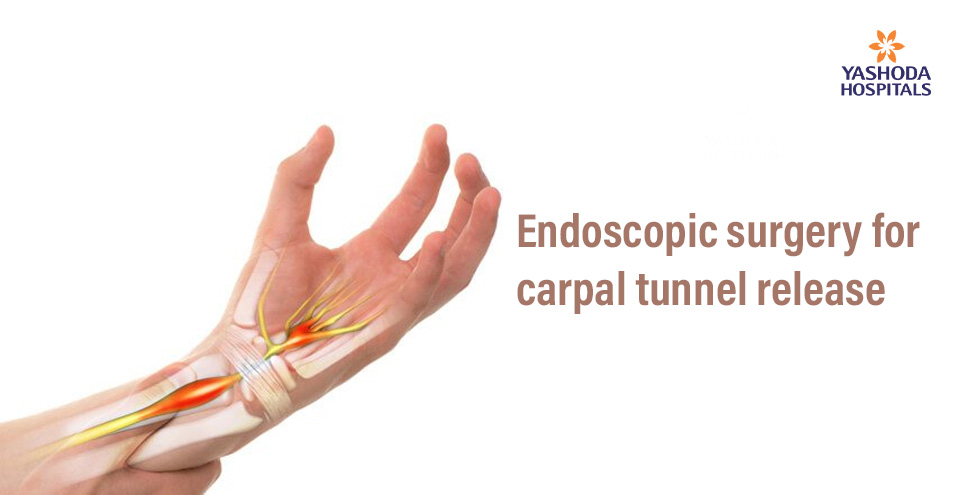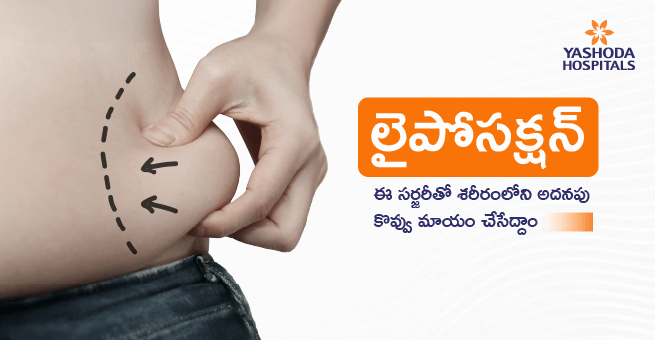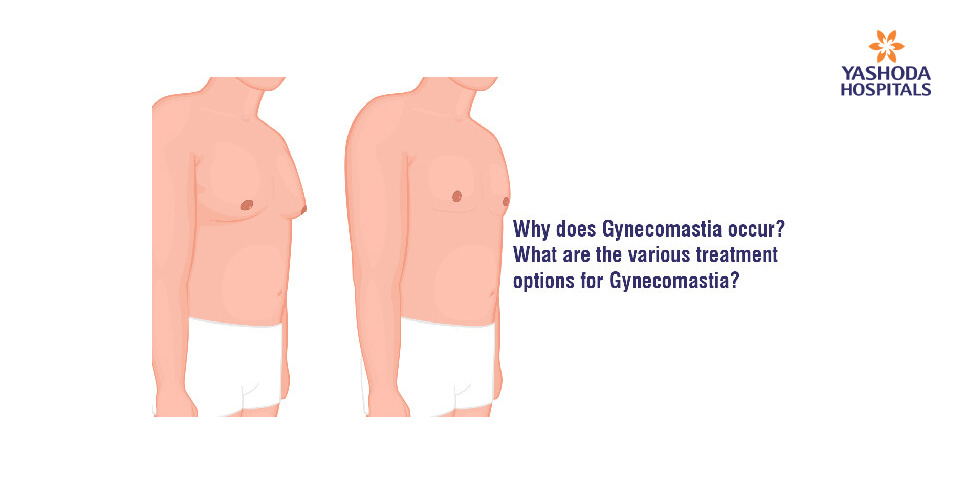Endoscopic carpal tunnel release surgery

At a Glance:
1. What is endoscopic carpal tunnel release surgery?
2. What is carpal tunnel syndrome?
3. How is carpal tunnel syndrome diagnosed?
4. What are the indications of endoscopic carpal tunnel release surgery?
5. What to expect before endoscopic carpal tunnel release surgery?
6. How is endoscopic carpal tunnel release surgery performed?
7. What are the advantages of endoscopic carpal tunnel release surgery?
8. What to expect during recovery after endoscopic carpal tunnel release surgery?
9. What are the risks of endoscopic carpal tunnel release surgery?
10. How should one choose a facility for endoscopic carpal tunnel release surgery?
What is endoscopic carpal tunnel release surgery?
Endoscopic carpal tunnel release is a minimally invasive surgery that is performed to treat a painful medical condition of the hand, known as carpal tunnel syndrome.
In endoscopic surgery, a thin tube or an endoscope fitted with a camera at its end is inserted through small ports or incisions. The endoscope allows the surgeon to visualize the structures in the surgical site without surgically opening the area with a longer incision. The surgery is performed using tiny cutting tools that are also inserted through these small incisions.
What is carpal tunnel syndrome?
The muscles and tendons of the forearm and the hand are supplied by the median nerve which also allows movements of the fingers. The median nerve passes through a narrow passageway in the wrist called the carpal tunnel. The wrist bones form the bottom of the carpal tunnel and the transverse carpal ligament forms the top of the tunnel within the wrist. An injury or swelling from inflammation of the tissues within the tunnel can cause a compression of the median nerve. As a result, symptoms like pain, and loss of function, numbness, and tingling appear gradually and may get worse over time. The thumb side of the hand is more severely affected. This condition is called carpal tunnel syndrome.
Some factors that increase the risk of carpal tunnel syndrome include:
- Activities that involve forceful or repetitive hand or wrist movement or use of vibrating equipment like driving, working with small instruments, knitting, etc
- Anatomy of the wrist: Some people may have smaller carpal tunnels than others
- Genetic predisposition: There is a higher risk if some of the close, first degree relatives have a history of carpal tunnel syndrome
- An injury like a sprain or fracture
- Medical conditions like diabetes, thyroid disease, and rheumatoid arthritis
- Pregnancy
Carpal tunnel syndrome is unlikely to resolve on its own, hence it is recommended to take proper treatment to relieve the tingling and numbness and restore wrist and hand function.

How is carpal tunnel syndrome diagnosed?
Doctors can diagnose carpal tunnel syndrome based on a person’s medical history, physical examination, and tests.
A detailed physical examination of the hand, wrist, shoulder, and neck is done to rule out other causes of nerve pressure.
Some of the commonly performed tests include:
- X-ray: Recommended to rule out other causes of wrist pain, such as arthritis or a fracture.
- Electromyogram:This test is done to evaluate the electrical activity when muscles contract and rest to identify muscle damage and out other conditions.
- Nerve conduction study: This is the main test to diagnose the condition. The test is done by passing a small shock through the median nerve and observe any slowing down of electrical impulses in the carpal tunnel. A positive test may be indicative of carpal tunnel syndrome.
What are the indications of endoscopic carpal tunnel release surgery?
Carpal tunnel surgery is indicated in diagnosed cases of carpal tunnel syndrome in the following conditions:
- Symptoms do not subside even after nonsurgical interventions for six months like:
- Over-the-counter pain relievers
- Physical therapy
- Changes to the equipment/tools used at work
- Wrist splints
- Steroid injections in the wrist to help relieve swelling and pain
- Weakening of the muscles of the wrist due to severe pinching of the median nerve.
- Persistent loss of feeling or coordination in the fingers or hand that restrict a person’s normal daily activities.
- Damage to the median nerve or a risk of damage to the nerve
What to expect before endoscopic carpal tunnel release surgery?
Before undergoing any surgery, a person needs to disclose the medical history and any medicines being undertaken. These could include any over-the-counter drugs, vitamins, supplements, etc. or any prescription medicines.
Medicines such as pain relievers and blood thinners can make it harder for the blood to clot, or some may interact with the medicines prescribed by the treating surgeon, hence it becomes important that the surgeon knows the person’s medication history.
The surgeon may advise the following:
- Blood tests and electrocardiogram (ECG)
- Stop smoking: As smoking can delay healing, so a person should try to quit smoking at least for a few days before the surgery if he/she is a smoker.
- Not to eat or drink anything for 6 to 12 hours before the surgery
- Specific preparations depending on the person’s medical condition
How is endoscopic carpal tunnel release surgery performed?
Carpal tunnel release is usually done on an outpatient basis. A person can go home the same day if the surgery is non-complicated. Carpal tunnel release surgery can be performed by the traditional method of open surgical release, in which the wrist is cut-open to do the surgery, or the other method is endoscopic carpal tunnel release. Once the necessary preparations have been done as per the protocols in the operation theatre, the endoscopic carpal tunnel release surgery is carried out as follows:
- A local anesthetic is used to numb the hand and wrist.
- The surgeon makes 2, half-inch incisions or ports, one on the wrist, and other on the palm. He inserts theendoscope into one of the ports. Through the camera attached to the endoscope, the surgeon to visualize the site of the surgery and insert the endoscopic surgical instruments through the same or the second incision.
- The transverse carpal ligament is cut through the incision. As a result, the pressure on the median nerve is relieved, thereby relieving the carpal tunnel syndrome symptoms.
- The incisions are closed with stitches.
- The hand and wrist are placed in a splint or bandaged heavily to prevent unnecessary movements of the wrist.
- Once the surgery is done, the person undergoing the procedure is monitored for a short time, and then allowed to go home.
- An overnight stay may be needed only in rare cases or in case of any complications.

What are the advantages of endoscopic carpal tunnel release surgery?
The small size of the incisions in endoscopic surgery causes less trauma to the adjacent structures like skin, muscle, and soft tissues and the procedure usually takes one hour to perform. This has many benefits like:
- No hospitalization: Since endoscopic carpal tunnel release surgery can be done under local anesthesia in most cases, it does not require hospitalization, allowing a person to be back on their feet a few hours following postoperative recovery.
- Lower risk for infections: The risk of post-surgical infections is lesser as compared to open surgery.
- Minimal bleeding: The small size of incision causes minimal blood loss and there minimal scarring.
- Lesspost operative pain: A person’s pain experience is minimal during and after the procedure.
- Lowerrisk for trauma: Since the procedure does not require cutting the palm open and disturbing a large area of the hand, the risk of trauma to adjacent tissue reduced. This leads to faster recovery and a quicker return to normal life.
- Minimal post operative scar: Less postoperative pain in the scar and proximal palm prevents activity limitation
- Shorter healing time: If surgery is needed on both wrists, endoscopic surgery is a more suitable choice as compared to open surgery because the healing time is shorter post endoscopic carpal tunnel release surgery.Also, for a person dependent on a wheelchair, a walker, or crutches endoscopic carpal tunnel release surgery is preferred. A person who has had endoscopic surgery may be able to return to work sooner than with open surgery.
What to expect during recovery after endoscopic carpal tunnel release surgery?
After the surgery is over, a person may have some amount of pain in hand and wrist that can be controlled with oral pain medicines. It may help to keep the affected hand elevated while sleeping at night to help decrease swelling.
The wrist may likely be bandaged or placed in a splint for 1 to 2 weeks and during this time, the surgeon may suggest the continuous movement of fingers to help prevent stiffness.
A physical therapy program may be advised once the splint is removed. The physical therapist will likely suggest a customized motion exercise plan to improve the movement of the wrist and hand. Adherence to such an exercise plan helps in speeding up healing and strengthen the area.
The symptoms of carpal tunnel syndrome like pain and numbness may go away at once after the surgery. However, in certain cases, it may take a few months. Heavy use of the hand should be avoided for a couple of weeks.
Depending on the hand in which surgery was done, whether the dominant hand with which a person performs work activities or not, a person may be able to return to work in a few days to a few weeks.
Adjusting to job duties, especially those involving repetitive work like continuous use of a computer mouse or assembly line jobs may be required during the healing phase. Activity restrictions if required are generally recommended by the surgeon after the surgery.
The gap where the ligament was cut gets filled with scar tissue eventually.

What are the risks of endoscopic carpal tunnel release surgery?
Endoscopic carpal tunnel release surgery is a safe and feasible option when performed by well-trained and experienced surgeons. However, though it is considered a safe procedure, it is not devoid of certain risks. These risks include general risks as well as some procedure-specific risks like:
General risks:
- Bleeding and infection at the site of surgery
- Collateral damage to the nearby structures like soft tissues, nerves or blood vessels
- Side effects of anesthesia that may include allergies in case of local anesthesia. Cases, where general anesthesia is used, may have the following risks:
- Drowsiness
- Headache
- Nausea
- Sore throat, due to the breathing tube if used during surgery
Procedure specific risks: Potential risks associated with the carpal tunnel release surgery include:
- Injury to the median nerve or nerves that branch out from it
- Injuries to nearby blood vessels or tendons
- A sensitive scar
The risk and complication rates for endoscopic surgery are extremely low. Major problems such as nerve damage may happen in fewer than 1% of cases.
The most severe complication is the return of symptoms of pain and numbness a temporary loss of strength when pinching or gripping an object, even though these are rarely reported.
How should one choose a facility for endoscopic carpal tunnel release surgery?
The choice of facility for availing treatment of conditions like carpal tunnel syndrome eventually depends on the person and his/her family and medical needs. However, an informed decision must be taken after considering the availability of the required expertise and infrastructure in the preferred facility.
Considering that minimally invasive procedures like endoscopic carpal tunnel release surgery are advanced and newer techniques, they are not available at every center due to the requirement of surgical expertise and state of the art equipment. Hence, such procedures are successfully performed in high-volume centers of excellence with the availability of diagnostic techniques like electromyogram and nerve conduction studies, technique trained and experienced surgeons and support staff.
Persons with carpal tunnel syndrome also special physical therapy needs. Led by plastic surgeons trained and experienced in procedures like endoscopic carpal tunnel release surgery, the Center for Plastic & Reconstructive Surgery at Yashoda Hospitals offers comprehensive services comprising of specialized teams for endoscopic plastic surgery procedures.
Conclusion:
The carpal tunnel syndrome is a common medical condition that affects the hand and wrist of a person. Compression or injury of the median nerve is the underlying pathology that causes the syndrome. Individuals who smoke or those with medical conditions like rheumatoid arthritis, diabetes, hypothyroidism are prone to developing carpal tunnel syndrome.
The most common presenting symptoms of carpal tunnel syndrome are numbness, paraesthesia, and pain in the affected area that may also be associated with a decrease in hand function at times.
The treatment for carpal tunnel syndrome includes non-surgical options and surgical interventions if non-surgical options fail. Prompt treatment can cure carpal tunnel syndrome completely.
In the endoscopic carpal tunnel release surgery, the surgeon cuts the transverse carpal ligament using a minimally invasive technique with small incisions under local anesthesia. The procedure does not require hospitalization and is associated with minimal complications and a faster recovery.
Read more about Endoscopic Carpal Tunnel symptoms, causes and treatment
If you find any of the above mentioned symptoms of Endoscopic Carpal Tunnel then
Book an Appointment with the best orthopedician in hyderabad
Reference:
- Mayo Clinic. Carpal Tunnel Syndrome. Available at: https://www.mayoclinic.org/diseases-conditions/carpal-tunnel-syndrome/diagnosis-treatment/drc-20355608. Accessed on December 30, 2019
- S. National Library of Medicine. Outcomes of endoscopic surgery compared with open surgery for carpal tunnel syndrome among employed patients: randomised controlled trial. Available athttps://www.ncbi.nlm.nih.gov/pmc/articles/PMC1482334/. Accessed on December 30, 2019
- American Academy of Orthopedic Surgeons. Carpal Tunnel Syndrome. Available athttps://orthoinfo.aaos.org/en/diseases–conditions/carpal-tunnel-syndrome/. Accessed on December 30, 2019














 Appointment
Appointment WhatsApp
WhatsApp Call
Call More
More